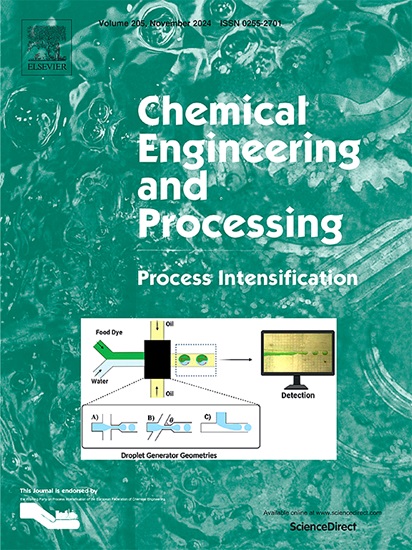Experimental study of an axial flow cyclone with ongoing dust removal from a settling tank
IF 3.8
3区 工程技术
Q3 ENERGY & FUELS
Chemical Engineering and Processing - Process Intensification
Pub Date : 2025-01-16
DOI:10.1016/j.cep.2025.110167
引用次数: 0
Abstract
The results of an experimental study are presented, the purpose of which was to evaluate the effect of geometric dimensions and flow parameters of an axial flow cyclone for different values of dust suction flux from the cyclone settler. The problem of current removal (by ejective suction) of dust from the cyclone settling tank with an additional flux is not sufficiently recognized in the field of numerical as well as experimental studies. The research conducted is novel and the results obtained are unique. It has been shown experimentally that the separation efficiency of the cyclone, in the range of inlet velocity υ0 = 2–10 m/s, increases intensively with an increase in the degree of dust suction m0, but only up to a certain value. The use of dust degree of suction above m0 =10–15 % is unjustified due to a slight increase in separation efficiency, a significant increase in pressure drops. The cyclone in the basic version and several variants with changed geometric parameters were studied. The phenomenon of suction shifts the characteristics of separation efficiency φc = (υ0) and pressure drop Δpc = (υ0) towards higher values. The introduction of dust suction from the settling tank at (m0 =15 %) results in an increase in the separation efficiency of the cyclone in the basic version by 5 %, and by 12 % after changing the geometry of the impeller and outlet tube. The use of current dust removal from the settling tank of the multicyclone of the two-stage filter not only results in an increase in separation efficiency and accuracy, but also significantly extends the period of efficient operation of the motor vehicle engine inlet air filtration system.
The results of an experimental study are presented, the purpose of which was to evaluate the effect of geometric dimensions and flow parameters of an axial flow cyclone for different values of dust suction flux from the cyclone settler. The problem of current removal (by ejective suction) of dust from the cyclone settling tank with an additional flux is not sufficiently recognized in the field of numerical as well as experimental studies. The research conducted is novel and the results obtained are unique. It has been shown experimentally that the separation efficiency of the cyclone, in the range of inlet velocity υ0 = 2–10 m/s, increases intensively with an increase in the degree of dust suction m0, but only up to a certain value. The use of dust degree of suction above m0 =10–15 % is unjustified due to a slight increase in separation efficiency, a significant increase in pressure drops. The cyclone in the basic version and several variants with changed geometric parameters were studied. The phenomenon of suction shifts the characteristics of separation efficiency φc = (υ0) and pressure drop Δpc = (υ0) towards higher values. The introduction of dust suction from the settling tank at (m0 =15 %) results in an increase in the separation efficiency of the cyclone in the basic version by 5 %, and by 12 % after changing the geometry of the impeller and outlet tube. The use of current dust removal from the settling tank of the multicyclone of the two-stage filter not only results in an increase in separation efficiency and accuracy, but also significantly extends the period of efficient operation of the motor vehicle engine inlet air filtration system.

求助全文
约1分钟内获得全文
求助全文
来源期刊
CiteScore
7.80
自引率
9.30%
发文量
408
审稿时长
49 days
期刊介绍:
Chemical Engineering and Processing: Process Intensification is intended for practicing researchers in industry and academia, working in the field of Process Engineering and related to the subject of Process Intensification.Articles published in the Journal demonstrate how novel discoveries, developments and theories in the field of Process Engineering and in particular Process Intensification may be used for analysis and design of innovative equipment and processing methods with substantially improved sustainability, efficiency and environmental performance.

 求助内容:
求助内容: 应助结果提醒方式:
应助结果提醒方式:


